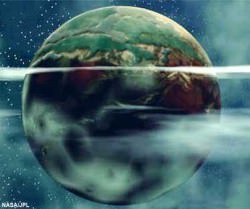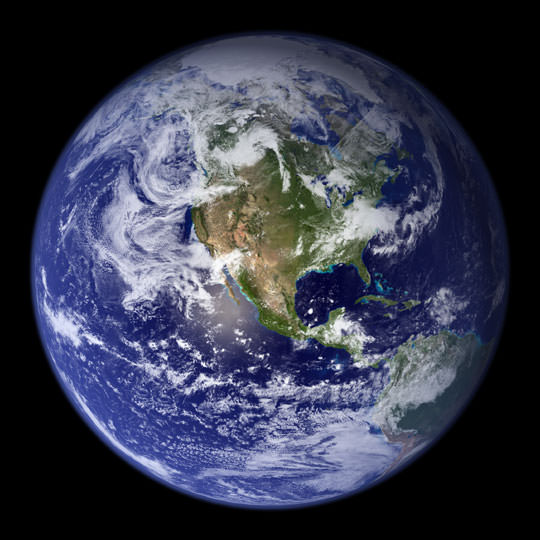[/caption]
Most scientists predict that in about a billion years, the sun’s ever-increasing radiation will have scorched the Earth beyond habitability. The breathable air will be toast, the carbon dioxide that serves as food for plant life will disappear, the oceans will evaporate; and all living things will disappear. Or maybe not. A group of researchers from Caltech have studied a mechanism which would cause any planet with living organisms to remain habitable longer than originally thought, perhaps doubling the lifespan. This sounds like good news for future inhabitants of Earth, but also, this mechanism could increase the chance that life elsewhere in the Universe might have the time to progress to advanced levels.
The researchers say that atmospheric pressure is a natural climate regulator for a terrestrial planet with a biosphere. Currently, and in the past, Earth has maintained its surface temperatures through the greenhouse effect. There used to be greater amounts of CO2 and other greenhouse gases in the atmosphere 1 billion years ago, which was a good thing. Otherwise, the Earth might have been a frozen ice cube. But as the sun’s luminosity and heat increased as it has aged, Earth has naturally coped by reducing the amount of greenhouse gases in the atmosphere, thus reducing the warming effect and making the surface of the planet comfortably habitable.
Opposite of what most scientists claim however, Caltech professor Joseph L. Kirschvink says that Earth may be nearing the point where there’s not enough carbon dioxide left to regulate temperatures using that same procedure. But not to fear, there’s another mechanism underway that may work even better to regulate temperatures on Earth, keeping our home planet comfortable for life even longer than anyone ever predicted.

In their paper, Kirschvink and his collaborators Caltech professor Yuk L. Yung, and graduate students King-Fai Li and Kaveh Pahlevan show that atmospheric pressure is a factor that adjusts the global temperature by broadening infrared absorption lines of greenhouse gases. Their model suggests that by simply reducing the atmospheric pressure, the lifespan of a biosphere can be extended at least 2.3 billion years into the future, more than doubling previous estimates.
The researchers use a “blanket” analogy to explain the mechanism. For greenhouse gases, carbon dioxide would be represented by the cotton fibers making up the blanket. “The cotton weave may have holes, which allow heat to leak out,” explains Li, the lead author of the paper.
“The size of the holes is controlled by pressure,” Yung says. “Squeeze the blanket,” by increasing the atmospheric pressure, “and the holes become smaller, so less heat can escape. With less pressure, the holes become larger, and more heat can escape,” he says, helping the planet to shed the extra heat generated by a more luminous sun.
The solution is to reduce substantially the total pressure of the atmosphere itself, by removing massive amounts of molecular nitrogen, the largely nonreactive gas that makes up about 78 percent of the atmosphere. This would regulate the surface temperatures and allow carbon dioxide to remain in the atmosphere, to support life.
This wouldn’t have to be done synthetically – it appears to happen normally. The biosphere itself takes nitrogen out of the air, because nitrogen is incorporated into the cells of organisms as they grow, and is buried with them when they die.
In fact, “this reduction of nitrogen is something that may already be happening,” says Pahlevan, and that has occurred over the course of Earth’s history. This suggests that Earth’s atmospheric pressure may be lower now than it was earlier in the planet’s history.

Proof of this hypothesis may come from other research groups that are examining the gas bubbles formed in ancient lavas to determine past atmospheric pressure: the maximum size of a forming bubble is constrained by the amount of atmospheric pressure, with higher pressures producing smaller bubbles, and vice versa.
If true, the mechanism also would potentially occur on any extrasolar planet with an atmosphere and a biosphere.
“Hopefully, in the future we will not only detect earth-like planets around other stars but learn something about their atmospheres and the ambient pressures,” Pahlevan says. “And if it turns out that older planets tend to have thinner atmospheres, it would be an indication that this process has some universality.”
The researchers hope atmospheres of exoplanets can be studied to see if this is occurring on other worlds.
And if the duration of habitability could be longer on our own planet, this might have implications for finding intelligent life elsewhere in the Universe.
“It didn’t take very long to produce life on the planet, but it takes a very long time to develop advanced life,” says Yung. On Earth, this process took four billion years. “Adding an additional billion years gives us more time to develop, and more time to encounter advanced civilizations, whose own existence might be prolonged by this mechanism. It gives us a chance to meet.”
Sources: Paper, Atmospheric pressure as a natural climate regulator for a terrestrial planet with a biosphere, Caltech


I find this conjecture very tenuous. I know many examples from Earth’s and its neighbours’ history which fly in the face of it.
I heard somewhere that it may be possible to raise the orbit of the Earth little by little over a long period of time by placing an object in an Elliptical Orbit around the earth which heads out towards the Outer Planets maybe we need to get started
There must be some sequestering mechanism for nitrogen. Biological organisms may fix nitrogen with nitrogenase activity. The resulting fixed nitrogen, in its low energy form as ammonia, would have to be buried by geological processes. There appears to be a lot of complexity and unknowns here.
As for the raising of the Earth’s orbit, this was proposed by Korycabsky, Laughlin and Adams back in 2001. The mechanism they propose is similar to what I found with Jupiter’s nudging of the Earth. The authors above suggested a 5000 period of nudging the Earth by pushing a comet to the inner solar system. Jupiter lacks the highly elliptical orbit, but it has a lot more mass.
This is interesting for laymen, as it bears on big questions, on life’s destiny but also on statistics of SETI, habitable zones et cetera.
It isn’t difficult to see why it is a tenuous model.
OTOH it seems to be testable, at least the authors think so. And there are AFAIU indications on sequestering and release of gases in atmospheres, such as claims that Earth dense atmosphere initially were at 10 bars of mostly CO2, the probable out-gassing of enough hydrogen to make Earth go from a reducing to an oxidizing atmosphere, and the later release of 20 % oxygen. Obviously then atmospheric, geological and biological processes have transformed the atmosphere completely.
So I am very curious and would be grateful for any examples from planetary history showing that nitrogen sequestering isn’t feasible.
Hmm, I found the paper, and it is fairly optimistic about the carbon sequestering compared to me. Claims 60 bars equivalents of carbon stored, 20 % or 10 bars of which is organic.
OTOH it is also optimistic on the nitrogen sequestering, simply uses a Redfield ratio on the above organic storage, and an optimistic one to boot. (6 compared to 10 on the paper I found. That is also comparable to the ratio of carbon:nitrogen fixation in soils (at PNK usage), so ~ 10 seems like a fair number.) But yes, according to these figures Earth has already stored away ~ 1 bar of nitrogen. Remains to find the evidence. 😮